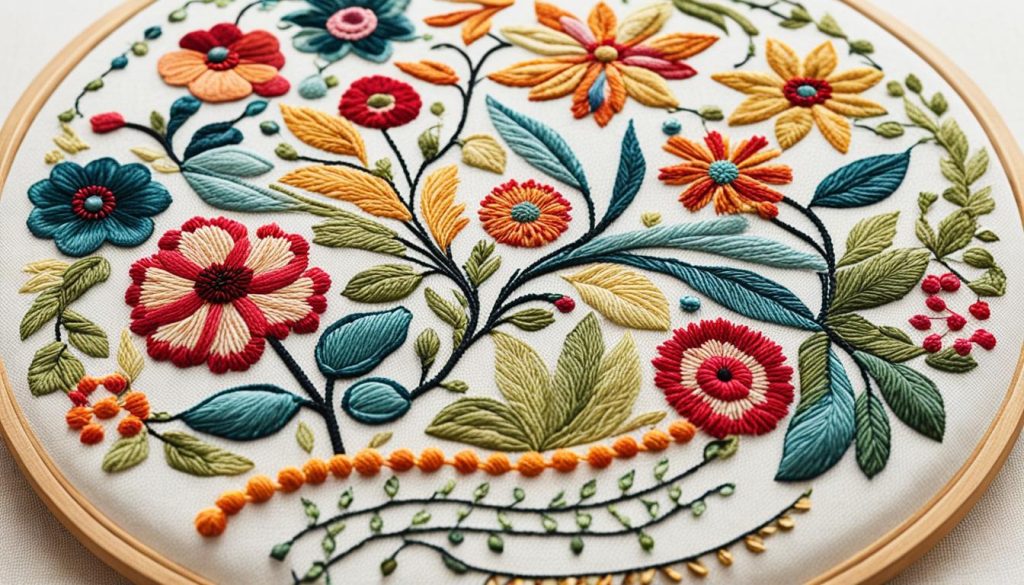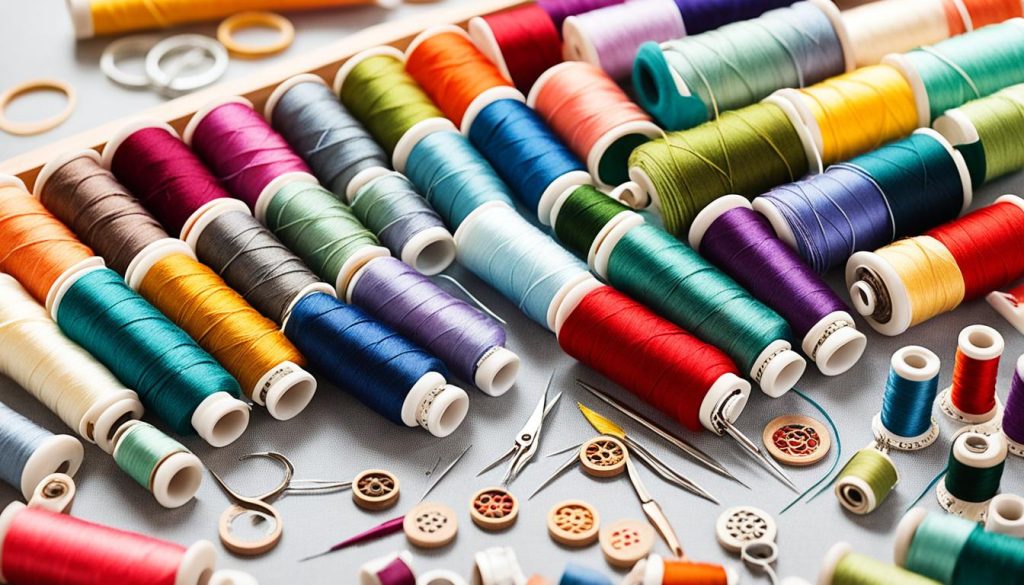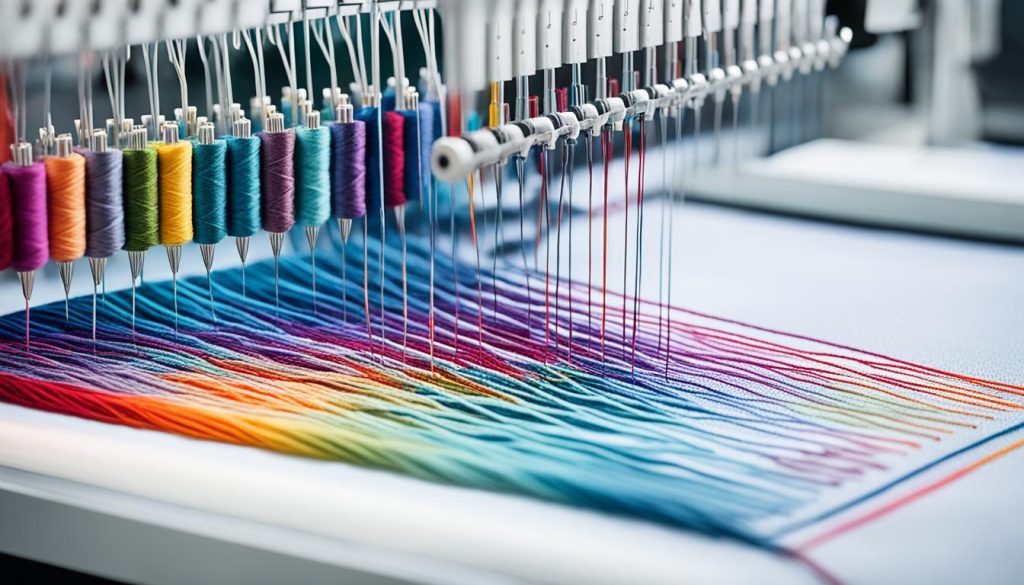Have you ever wondered why Embroidery continues to thrive in today’s tech-driven world? Its roots trace back thousands of years to ancient civilizations like China, Persia, and Egypt, where thread art was used to convey cultural identity, status, and storytelling.
Every design—whether stitched by hand or machine—tells a story. It captures the artist’s creativity, the era’s aesthetics, and cultural symbols. Today, you’ll see everything from classic blackwork to digitally crafted pieces, blending heritage with innovation. The artistry behind each piece reveals how much meaning can be woven into a single stitch.
Despite modern advances, hand-stitched work still holds a special place. Its warmth and authenticity bring a human touch that machines can’t fully replicate. Throughout this journey, we’ll explore why handcrafted needlework remains cherished in an age of automation.
Key Takeaways
-
Needlecraft originated in ancient cultures such as China, Persia, and Egypt—used to express identity, tradition, and artistry.
-
The world of thread art includes diverse forms like Blackwork, Whitework, Goldwork, and Crewel.
-
Color symbolism plays a key role: red signifies love, blue evokes calm, and green represents growth and renewal.
-
Digital tools and software have revolutionized stitching with complex, highly detailed designs.
-
Handmade work is making a strong comeback for its uniqueness and personal charm—qualities machines can’t replicate.
-
This craft spans high fashion, streetwear, home décor, and functional design.
-
Top fashion houses like Gucci, Dior, and Louis Vuitton regularly feature intricate needlework in their collections.
-
Get inspired by the community (or explore some new patterns – click here for free ideas)
Introduction to Styles of Needlecraft
Thread-based design is more than just decorative—it’s a vast universe of styles and techniques that reflect cultural histories and artistic expression. From precise counted stitches to expressive freeform work, each approach highlights the maker’s skill and vision.
Cross-stitch, dating back to around AD 850, remains one of the most beloved forms of counted thread work. In Victorian Britain, Berlin woolwork became the leading style, boasting over 14,000 published patterns by 1840.
Let’s explore some iconic types of needlework and why they matter:
-
Canvas Work – Popular since the 16th century, often used to embellish furniture, cushions, and bed hangings with geometric and floral designs.
-
Kogin Stitching – A style from Japan’s Edo period, once nearly lost but now revived in modern textiles and fashion.
-
Art Needlework – Promoted by William Morris in the 19th century, it aimed to restore traditional techniques and move away from mass-produced Berlin designs.
-
Chinese Silk Techniques – Includes four regional forms: Shu xiu, Su xiu, Xiang xiu, and Yue xiu, each showcasing delicate precision and centuries of heritage.
Embroidery is always changing, not just history. Today, there are many online tutorials for learning. You can find step-by-step guides for mastering different stitches, making it easier for both beginners and those looking for a new project to try.

| Style | Origin | Features |
|---|---|---|
| Berlin Woolwork | Victorian Britain | 14,000 patterns by 1840, needlepoint |
| Cross-stitch | AD 850 | Widely used, adaptable designs |
| Kogin | Japan (Edo Period) | Revived in 20th century, household items |
| Canvas Work | 16th century | Bed hangings, cushion covers, upholstery |
| Art Needlework | 19th century | Restoration of traditional techniques, natural hues |
| Chinese Silk | Various regions | Distinct regional styles and motifs |
Color in embroidery is very important. It often holds deep cultural meanings. This brief look will lead to a deeper understanding of embroidery. We’ll explore the craft in more depth, looking at the materials and techniques. Embroidery truly is a form of creative expression, with each stitch telling its own story.
A Historical Overview of Embroidery Techniques
Embroidery is an ancient art form, dating back thousands of years. It tells stories with intricate designs.
Ancient Origins
The story of embroidery starts with early civilizations. People began with it around 30,000 B.C., during the Cro-Magnon era. In ancient China, embroidery became a work of art from the 5th to the 3rd centuries B.C. The Vikings in Sweden also adopted this craft during the 9th and 10th centuries.
By the year 1000, embroidery was thriving in Europe. This ancient art has grown and changed over time, always reflecting cultures and personal stories.
Medieval and Renaissance Embroidery
In the Middle Ages, embroidery showed off wealth and status. The Opus Anglicanum method in medieval England was particularly lavish, using gold thread. By the Renaissance, embroidery was common in the palaces and churches of Europe.
Surprisingly, men like Henry Fonda and King Gustaf of Sweden were skilled embroiderers. This shows that embroidery was valued by all, regardless of gender.
Modern Embroidery Trends
Things changed in the 19th century with the invention of the first embroidery machines in France. This made embroidery quicker and more available. The early 1900s saw the first pattern papers and catalogs, which made embroidery popular everywhere.
Today, we have computerized embroidery machines making the craft easier than ever. There’s a new interest in handmade and sustainable goods. This includes clothing and home decorations, showing that embroidery is still a beloved art form.
| Era | Significant Developments |
|---|---|
| 30,000 B.C. | Early embroidery origins traced back to the Cro-Magnon era |
| 5th-3rd centuries B.C. | Ancient Chinese embroidery emerged |
| 9th-10th centuries | Embroidery during the Viking Age in Sweden |
| Medieval Era | Embroidery becomes a status symbol; introduction of Opus Anglicanum |
| Renaissance | Rich materials and intricate designs flourish |
| Mid-1800s | Invention of first embroidery machines in France |
| Late 1800s-early 1900s | Mass production and spread through catalogs and pattern papers |
| Modern Era | Computerized machines and revival of handcrafted techniques |
Hand Embroidery Techniques
Hand embroidery lets you add your own unique style to fabric. It’s all about freedom and choice. You’ll learn the important stitches and materials to get started on this amazing craft.
Popular Hand Embroidery Stitches
The beauty of embroidery lies in its stitches. The satin stitch is great for filling areas with color, and it’s super popular. If you’re new, start with the easy running stitch. It’s basic and important for many designs.
The backstitch is also easy to learn and very strong. Using the split stitch gives a cool textured look. No wonder the French knot is known as challenging—it makes neat little dots. The fly stitch, on the other hand, is easy and good for many shapes.
For more advanced looks, there’s the feather stitch. Then there’s the bullion knot, which is both fancy and effective. Many stitches mean many ways to make your embroidery stand out.
The next part shows different stitches you can try. It’s a great guide for your embroidery journey.
| Embroidery Stitch | Description | Difficulty Level |
|---|---|---|
| Running Stitch | Basic stitch, easy to execute | Easy |
| Backstitch | Strong, versatile stitch | Easy to Moderate |
| Satin Stitch | Fills areas with color | Moderate |
| French Knot | Knotting technique for textured dots | Challenging |
| Split Stitch | Strong, textured lines | Moderate |
| Bullion Knot | Advanced, creates intricate roses | Advanced |
Materials and Supplies
Starting with hand embroidery means gathering the right tools. You’ll need items like cotton, linen, and silk fabric. An embroidery hoop is key for keeping your work tight and neat.
For making beautiful designs, gather various threads in many colors. Make sure to have different needles for different stitches. This helps you achieve the look you want.
If you’re new, an embroidery kit is a great choice. It includes everything you need to start. Having the right materials means you can put your focus on learning the stitches.
After you make your art, take good care of it. Hand washing and air drying will keep it looking fresh. With the right supplies, you’re ready to make something amazing.

Machine Embroidery: Innovation Meets Creativity
Machine embroidery combines traditional craftsmanship with the accuracy of today’s technology. It can create a simple monogram or a complex scene. Various methods meet specific design needs. The use of features like changing thread colors automatically and trimming threads has revolutionized the industry. These additions have updated a craft that’s been around for a long time.

Types of Machine Embroidery
Your choice of embroidery machine is key, especially for your business. Single-needle machines are great for beginners or those with limited room. But multi-needle machines are better for professionals or those who love embroidery. They allow you to work with multiple thread colors without stopping to change threads.
Standalone machines have big embroidery areas and advanced features. They are best for those who focus on embroidery work. Brands like Bernina offer machines that can handle up to sixteen threads. This is very useful for businesses that need to produce a lot of embroidery.
Combination machines offer both sewing and embroidery functions, perfect for those who do a bit of both. They’re a good choice for when you’re short on space or on a budget. These machines vary in speed, embroidery size, and have features like color touch screens. This ensures there’s a machine that fits everyone’s needs.
Software and Tools
Digital embroidery software is essential for making and refining designs. Programs like Embird and Hatch have changed how we work with designs. They offer various embroidery fonts to make your projects stand out more.
Today’s machines also have automatic tension controls for the right stitch tension. They use inline thread colorization to send the correct thread color directly. This means you can blend colors without stopping to trim threads. Plus, with networking features, your machine can alert you to any issues while you work.
It’s really important to keep your machines well maintained. Regular cleaning and oiling will make them last longer.
All these advances in technology and software aim to make embroidery easier, more precise, and efficient. It’s important to pick the best machine and software combo for your embroidery business.
| Machine Type | Features |
|---|---|
| Single-Needle | User-friendly, suitable for beginners or limited space |
| Multi-Needle | Work with multiple colors without manual thread changes |
| Standalone Machines | Advanced features, larger embroidery areas |
| Sewing-Embroidery Combo | Versatile for users interested in both crafts |
| Commercial-Grade | Handles up to sixteen threads, suitable for mass production |
Custom Embroidery: Personalizing Your Craft
Custom embroidery lets you add personal touches to your things. It turns your items into unique statements of your style. Many people love this craft for its power to change pieces with custom embroidery. It’s great for fashion or making your home special.
Designs and Patterns
There are all kinds of custom embroidery patterns. You can choose from delicate flowers to simple shapes. You might want a fancy design for a dress, or a bold one for your wall. Making each pattern your own is what makes your project stand out.
From Fashion to Home Décor
Embroidery isn’t just for old-fashioned linens anymore. You can find it on modern pieces like pillows and hangings. It adds a unique touch to any space. And for those into fashion, custom embroidery makes clothes, hats, and more one-of-a-kind.
Custom Embroidery LLC in Conyers, Georgia, is a leader in personalized embroidery. They work with teams, small shops, and others, making custom embroidered items. People love the bright colors and fast service they get with every order.
Here’s a quick look at their pricing for name embroidery:
| Units Ordered | Cost per Unit | Savings |
|---|---|---|
| 5-9 | $8 each | N/A |
| 20-49 | $6 each | Save 20% |
| 50-99 | $5 each | Save 30% |
| 100-199 | Negotiable | Save 40% |
They promise top-notch work and great service. Custom pieces are sure to please. Ordering is straightforward, and you can see your design before it’s made. Custom Embroidery LLC helps you create something truly special.
Techniques in Fashion
Embroidery is a big deal in the fashion world. It’s popular in both fancy high fashion and everyday streetwear. It adds a special touch to clothes, making them unique and rich-looking.
Embroidery in High Fashion
In high fashion, embroidery means luxury and skill. Big names like Gucci, Dior, and Louis Vuitton use it to make their clothes stand out. You’ll see fancy patterns, shiny metallic threads, and tiny careful details in their designs.
Look at Gucci’s jackets and dresses. They have beautiful flower patterns and detailed designs. Then, there’s Dior, showing off embroidery styles from long ago, like the Anundsjösöm stitch. These techniques give their clothes a classic, upscale feel.
Embroidery in Streetwear
On the other hand, streetwear uses embroidery for a chill, but powerful, vibe. Brands such as Supreme, Off-White, and BAPE turn simple clothes into urban statements. Their detailed embroidery shouts about personal style.
Take Off-White’s famous arrow symbols, which stand out because of the embroidery. Or Supreme’s limited drops, where they add cool designs with embroidery. These brands mix art with casual clothes. Plus, they’re using themes from places like the Democratic Republic of the Congo to stay fresh.
Both high fashion and streetwear show how cool it is. It fits everywhere, from the poshest designer collections to unique urban looks. Embroidery stays popular because it’s both classic and keeps changing with the times.
Conclusion
Needlecraft blends age-old traditions with modern creativity. From hand-stitched details to high-tech machines, the art continues to evolve while staying relevant.
On platforms like Instagram, the #handembroidery hashtag grew from 1 million to 4.5 million posts—proof that this form of textile design is gaining momentum. Online learning sites like Craftsy and Domestika also reflect rising interest in handmade stitching.
Hand techniques are central to the slow fashion movement, offering eco-friendly, one-of-a-kind creations. Meanwhile, machine-powered methods are ideal for large-scale production and are enhanced by design software. Still, manually digitized patterns often offer better precision and control.
From cushions to couture, every stitch tells a story. Whether you’re making wearable art or exploring new styles, this timeless craft remains uniquely expressive and deeply personal.
FAQ: Stitchwork, Style & Innovation
What’s the difference between hand stitching and machine work?
Handcrafted designs are personal and expressive, made using simple tools like a hoop and needle. Machine-driven versions use software and technology to produce clean, uniform results with speed and accuracy.
Why is color so important in textile design?
Color choices bring emotion and meaning to a piece. They highlight details, reflect culture, and give life to each design—turning thread into visual storytelling.
What are the most common styles of decorative stitching?
Popular forms include Blackwork, known for its intricate geometric patterns, and Crewel, loved for bold textures and vibrant threads. Each style uses different techniques to achieve a unique effect.
How has thread art changed over time?
Originating in ancient civilizations like China and Egypt, it evolved through religious and royal themes in the Middle Ages and Renaissance. Today, it combines heritage with innovation through digital tools and creative freedom.
What materials do you need to get started with handwork?
Basic tools include a hoop, sharp needles, cotton or silk threads, and natural fabrics like linen or muslin. Starter kits with patterns are ideal for beginners.
How can this craft be used in home décor?
You can embellish cushions, wall hangings, towels, and table linens. It adds a personal, artistic touch that reflects your individual style and creativity.
Which stitches should beginners learn first?
Foundational techniques include the stem stitch, French knot, and satin stitch. These offer different textures and open the door to a wide range of patterns.
What’s the role of decorative stitching in fashion?
It adds artistry and craftsmanship to both luxury garments and streetwear. High-end labels like Gucci use it to enhance elegance, while brands like Supreme use it for standout details.
How does software help in machine stitching?
Programs like Embird or Hatch allow you to digitize, resize, and color designs with ease. They enhance creativity and precision, making complex projects more manageable.
